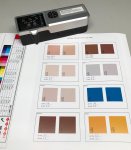Magnus
Well-known member
Hi, for years we have been using ∆E CIELAB 1976 calculation when measure color deviation on print and proofs (and displays sometimes). A year ago I was on a seminar with a color specialist from GMG who talked about ∆E 2000 as a successor of the old 1976 formula. He said that one of the advantage of ∆E 2000 is that it's not linear, but instead calculate the deviation of color more like the perception of the human eye (under the correct light conditions). I though this sounded like a good step in the right direction regarding color communication. Now ∆E 2000 has also been added in the new ISO 12647-7:2016 for proofing.
The last days I've been measuring prints and proofs with both ∆E CIELAB 1976 and ∆E 2000 to see if theory matches reality. Saturated full tones and gray balance are measuring as I expected. But I've noticed that skin tones is actually affected the opposite way than I expected. The ∆E-value of sensitive skin tones is actually lower when measuring with ∆E 2000. IMHO deviation in the hue of a skin tone is one of the main things that customers would take notice of.
When I look at the visual representation of ∆E 2000 vs ∆E CIELAB 1976 I looks like ∆E 2000 should be more sensitive than ∆E CIELAB 1976 in skin tones, but my tests give me the opposite results.
I've done all measuring with a brand new Techkon SpectroDens Premium New Generation (D50 2°) and also cross checked with an Xrite i1Pro 2.
What's your thought about this? Am I missing something? Do you got any other input?
Here's a link to my test file if you want to give it a try: https://www.dropbox.com/s/tvprgkd6czg70fe/Delta_E_Test.pdf?dl=0
The last days I've been measuring prints and proofs with both ∆E CIELAB 1976 and ∆E 2000 to see if theory matches reality. Saturated full tones and gray balance are measuring as I expected. But I've noticed that skin tones is actually affected the opposite way than I expected. The ∆E-value of sensitive skin tones is actually lower when measuring with ∆E 2000. IMHO deviation in the hue of a skin tone is one of the main things that customers would take notice of.
When I look at the visual representation of ∆E 2000 vs ∆E CIELAB 1976 I looks like ∆E 2000 should be more sensitive than ∆E CIELAB 1976 in skin tones, but my tests give me the opposite results.
I've done all measuring with a brand new Techkon SpectroDens Premium New Generation (D50 2°) and also cross checked with an Xrite i1Pro 2.
What's your thought about this? Am I missing something? Do you got any other input?
Here's a link to my test file if you want to give it a try: https://www.dropbox.com/s/tvprgkd6czg70fe/Delta_E_Test.pdf?dl=0
Attachments
Last edited:














